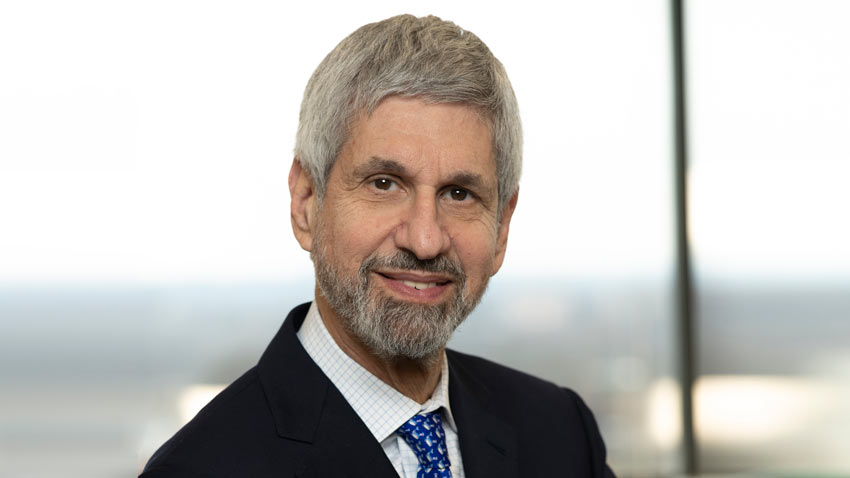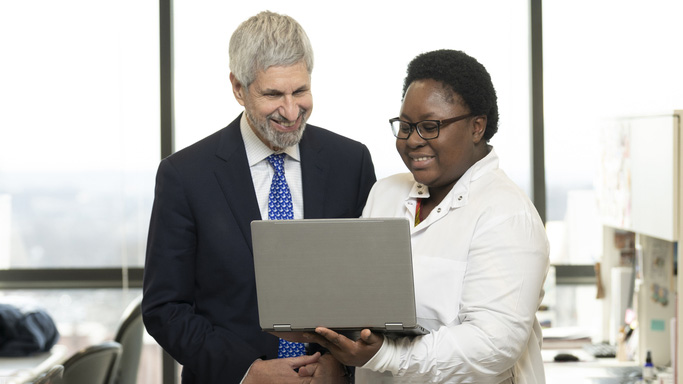CHILDREN'S NATIONAL RESEARCH INSTITUTE ACADEMIC ANNUAL REPORT 2021

From the Chief Academic Officer
Reflections on Pediatric Academic Medicine at Children’s National Hospital
Questions and Answers with the Chief Academic Officer
Mark L. Batshaw, M.D., discusses the past, present and future of Children’s National Hospital and academic medical research as he prepares to retire from his longtime role as chief academic officer and director of Children’s National Research Institute.
Why did you come to Children's National?
One of the things that drew me to Children’s National was its location in the nation’s capital. I thought there was an opportunity to create a world-class academic health system for children in Washington, D.C.
Second, I love children's hospitals. When I came here to interview, I felt the culture was wonderful—an institution built not around the walls of a physical building but around the people who inhabit it and the mission to make children stronger.
Third, I could continue my clinical work in developmental pediatrics and my research on rare genetic diseases. I could grow as a leader and keep doing my own work as a clinician-scientist, too.
What was research like at the hospital when you arrived?
In 1998, when I arrived, Children's National had a strong reputation as a clinical institution and as a great place to do a residency but had a rather small research focus. We were ranked number 53 out of 135 departments of pediatrics and children’s hospitals in terms of NIH funding for research—amounting to only about $4 million a year.
Where does Children's National stand in terms of pediatric research today?
Today we’re ranked number 7 among children's hospitals in terms of NIH-funded research, with well over $54 million per year of funding from the NIH alone. We have an almost $100 million annual research expenditures. The number of faculty at Children’s National has grown from 180 to 900+, annual peer publications increased from 100 to over 1,000, and our presentations at the Pediatric Academic Societies meeting went from 10 total to more than 100 each year. When I started, we had one significant research center—the Center for Cancer and Immunology Research. We now have five major research centers led by some of the most respected and established investigators in their fields.
I’d say that research here has really transformed during the two decades that I’ve had the honor of serving as director of the Children’s National Research Institute and as chief academic officer.
Can you reflect on what you think is the biggest milestone that occurred in your tenure here? Why is it so significant?
The Children’s National Research & Innovation Campus has to be one of the biggest milestones. It is a remarkable achievement, not just in terms of our ability to secure congressional support for our acquisition of the campus, but also the enormous financial and institutional commitment it has taken to make it a reality. It's a capstone of my career.
How has pediatric research changed in the last 20 years?
Rare diseases are an area that has markedly expanded the profile of pediatric research over the last two decades, probably more than anything else. Children’s National Hospital was one of the first NIH Rare Disease Clinical Research Centers to study them. We also launched the Rare Disease Institute, led by Marshall Summar, M.D., Chief of Clinical Genetics and Metabolism.
Pediatric research is still not getting as much support financially as adult-focused research. Children under 18 represent 23% of the population, but the total funding of pediatric research at NIH is closer to 14%; it is still not where it needs to be.
Do you see Children's National as having played a key role in that evolution of pediatric research? How?
I think we have had a lot of firsts but I will just name two:
- The Sheikh Zayed Institute is the only pediatric surgical innovation institute in the country.
- Our Clinical and Translational Science Institute at Children’s National (CTSI-CN) is the only clinical and translational science award from the National Center for Advancing Translational Medicine (NCATS) at NIH given to a children’s hospital. The center is led by Lisa Guay-Woodford, M.D.
Are there one or two scientific advances here at Children’s National that have helped move research about children's health forward?
Children’s National Hospital stands out in many areas of note, including rare diseases, cellular immunotherapy, pediatric surgical devices and basic research of developmental disabilities. Some key research areas where we have contributed in a big way include:
- The development of vamorolone, a steroid-like compound without the side effects we see in steroids. Long-term steroid use has major side effects, including weight gain, bone health and behavioral health issues. A drug that did the work of steroids but didn't have these side effects could transform care for patients with muscular dystrophy and other conditions.
- For treatment of urea cycle disorders, we have played an essential role in getting three new drugs approved by the FDA. Though these are disorders extremely rare, it is something transformative because these drugs have changed these conditions from fatal diseases to treatable ones. With gene therapy advances, maybe we’ll even potentially have a cure.
- We have launched several first-in-human studies in cellular immunotherapy, under the direction of Catherine Bollard, M.D., MBChB, director of the Center for Cancer and Immunology Research. This work for both cancer and immune disorders has a potentially enormous impact on some cancers for which we do not have great treatments—especially leukemias.
- Integrating global health into precision and genomic medicine. Today, so much of precision medicine is based on what we know about the Caucasian genome. Studies in the Center for Genetic Medicine Research by Eric Vilain, M.D., Ph.D., focus on understanding and sequencing genomes from other regions of the world and understanding variants that affect a person’s risk for disease or require different treatments. This is unique work that may ultimately have a significant impact on how we address health inequities here in the U.S. and around the world.
- The Center for Neuroscience Research has published many significant works in the prestigious journals Nature and Science focused on the mechanisms of brain development, neonatal brain injury and neurodevelopmental disorders, which were not well understood before.
- For two decades, we’ve also led the Washington, D.C. Intellectual and Developmental Disabilities Research Centers (IDDRC), funded by the NIH. Our unique partnership across four research institutions in Washington, D.C., led by our Interim Chief Academic Officer and Interim Director of Children’s National Research Institute (and former director of the Center for Neuroscience) Vittorio Gallo, Ph.D., has given us major insights into how we understand and care for children with intellectual and developmental disabilities.
What is needed for pediatric research to further grow and evolve? What's next in the field?
There are a few things we need to continue growing and evolving research to improve children’s health:
- Funding. The federal government and philanthropists should focus more on funding child health research and supporting the career development of a diverse group of clinician investigators focused on pediatric medicine.
- Facilities. We need more physical expansion of facilities dedicated to pediatric research, similar to what Children’s National is doing with its Research & Innovation Campus.
- Recruitment of the next generation of pediatric scientists. The training we do at Children's National has led to many of the advances here. We train 1,600 physicians every year, including medical students, residents, and fellows, many of whom come to our clinical and basic science research programs to learn how to do research. This effort needs to be continued and enhanced.
How do we keep faculty interested in research when they are already balancing academics, clinical practice and family time?
When I started my career, the average pediatrician retired at 62. Now the average retirement age of an academic physician is 72. By the time the current generation of medical students is ready to retire, it will probably be 82! So, faculty members may have 50 years to develop a career--they don't need to do it all at once. We need to support our trainees and physicians in ways that promote the right work-life balance and give them the opportunity to consider adding research to a clinical practice. It is more than juggling home life and work; it involves balancing clinical care, teaching, research and advocacy that comprise our mission at Children’s National. We need to help guide people on the best ways to balance those demands and keep the right priorities.
Where do you see CNRI and research in general headed from here?
Wayne Gretsky, the great hockey star, used to say: “Skate to where the puck is going to be, not where it’s been.” That's what we need to think about—where the puck will be.
What are some of the areas that you think will expand in pediatric research in the next decade or two?
Here is my list:
- Precision medicine. Understanding genomic medicine and how that's going to affect our treatment of disease. For example, we know now that asthma is not a single disease—it is a final common pathway. We have to understand how people and children are different in their reactions to asthma because that will affect how we care for them.
- Epigenetics, or how the environment affects gene expression. For example, we need to understand how stress in a family or pregnant mother due to challenges, such as food insecurity, physical or emotional abuse, or other factors, affects a child’s growth and development. We know now that these factors can affect gene expression in the unborn child, impacting cardiac health and the likelihood of obesity decades later.
- Gene therapy and gene editing. These techniques may have curative effects on certain rare diseases and cancers
- Cellular immunotherapy. These approaches also have enormous potential for the future treatment of cancer and immune diseases.
- Prenatal medicine. It’s arbitrary to say that pediatrics begins at the child’s birth, especially when birth can be at 23 weeks or 44 weeks. The field of fetal medicine is likely to advance markedly in the future.
- Digital health and biosensors. Looking at how these technologies can provide health care differently and defining the research that can be done with and in the community to understand how these strategies can work better will advance.
- Artificial intelligence and machine learning. Researchers at Children’s National are working on ways to use artificial intelligence to identify genetic diseases in newborns using cell phone photos. Another example is using machine learning to refine a diagnosis, for example, listening to the heart with a stethoscope and using AI to determine if a murmur is benign or needs a follow-up.
- Regenerative medicine and 3D tissue printing. This area may explode in the next decade. We have to prepare people with the technology and the knowledge to pursue it.
What’s next for you after you retire from your current role?
Even though I am retiring as CAO, I will be around for a while to do what I can to help make this future a reality at Children's National. I plan to run a residents’ clinic to see children with developmental disabilities, my clinical area of expertise, and co-direct a new Leadership Education in Neurodevelopmental Disabilities grant with Andrea Gropman, M.D.. I plan to continue to mentor and help faculty members write grants and remain involved in some other large institutional initiatives, including thinking through what’s next for our Research & Innovation Campus. I’ll stay on as a senior adviser to our CEO, Dr. Kurt Newman, as the organization continues to evolve and grow. I think there is an opportunity for some really exciting initiatives.

